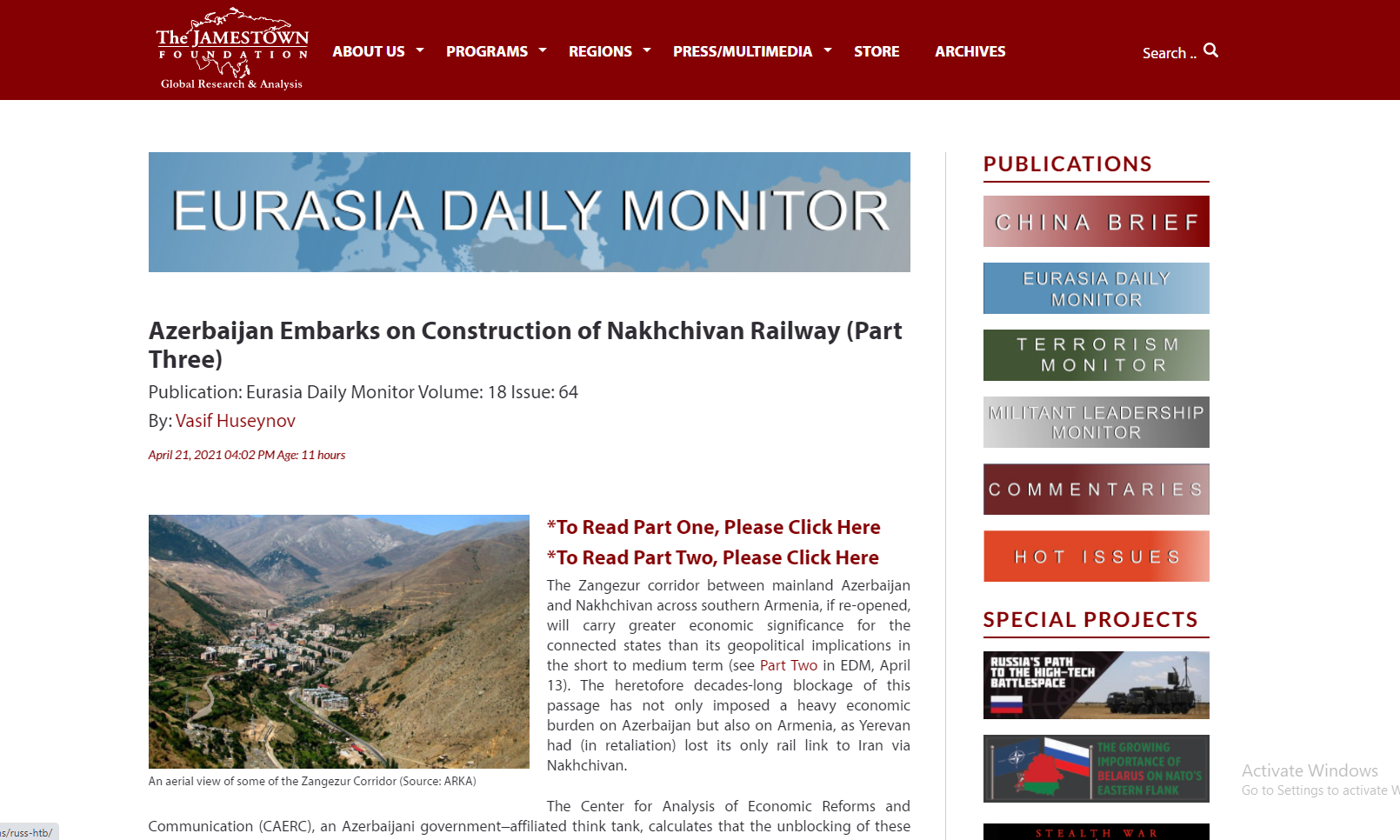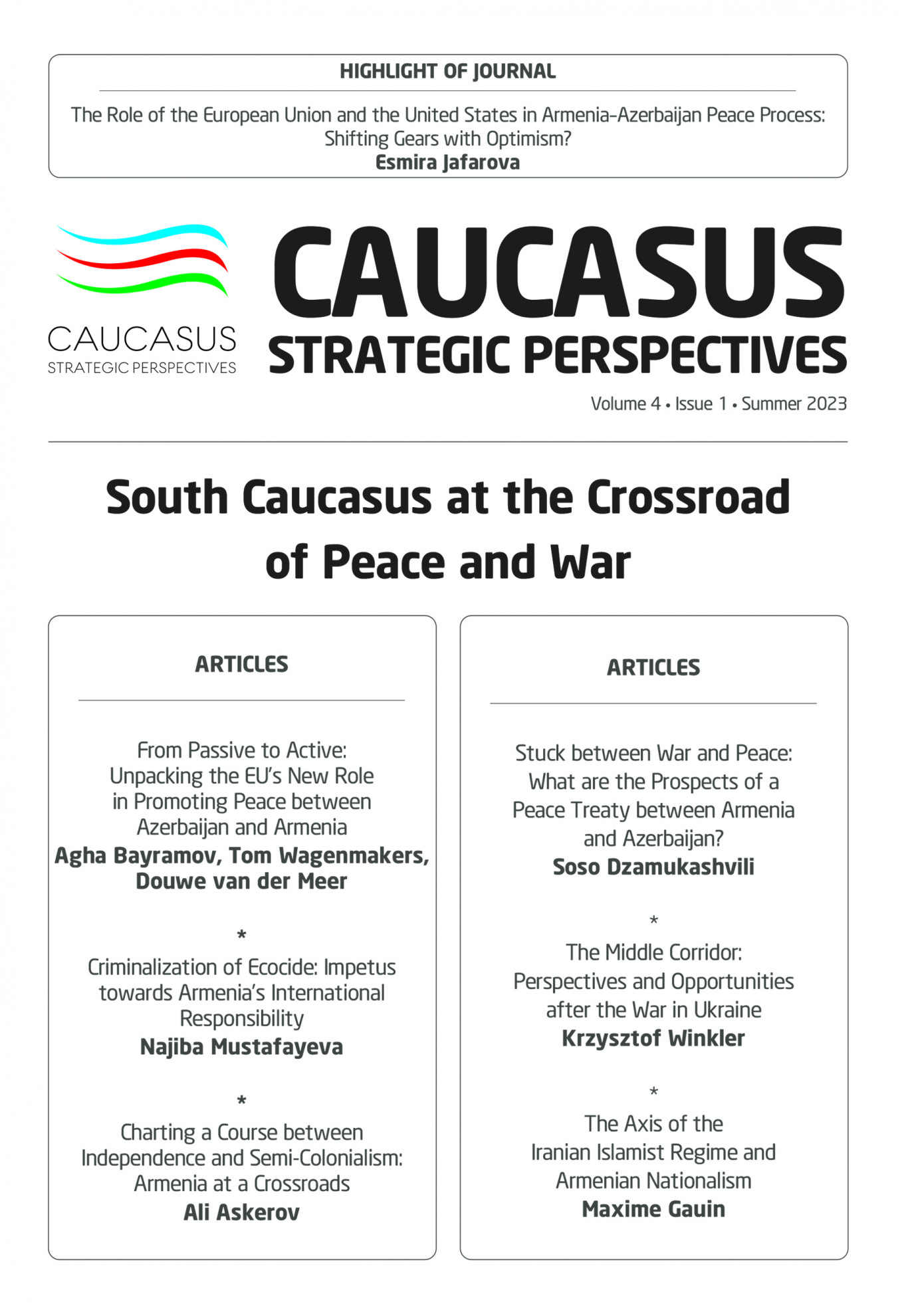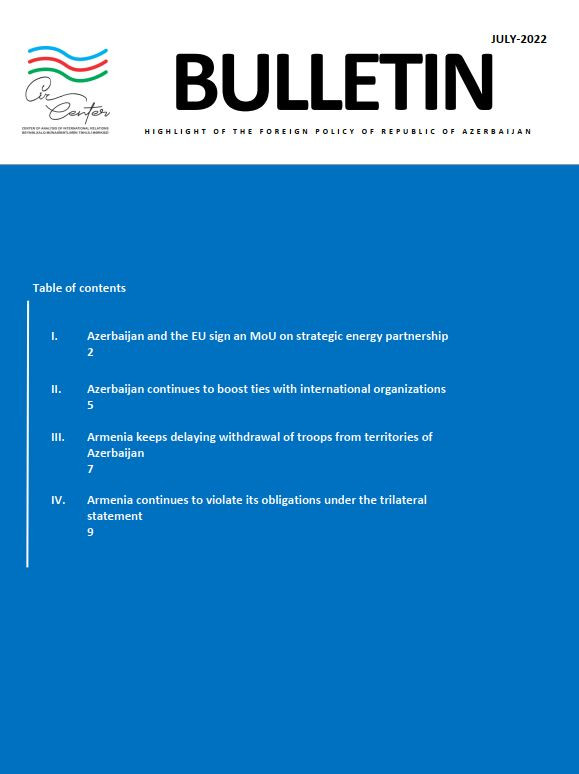The Zangezur corridor between mainland Azerbaijan and Nakhchivan across southern Armenia, if re-opened, will carry greater economic significance for the connected states than its geopolitical implications in the short to medium term (see Part Two in EDM, April 13). The heretofore decades-long blockage of this passage has not only imposed a heavy economic burden on Azerbaijan but also on Armenia, as Yerevan had (in retaliation) lost its only rail link to Iran via Nakhchivan.
The Center for Analysis of Economic Reforms and Communication (CAERC), an Azerbaijani government–affiliated think tank, calculates that the unblocking of these regional transportation links can increase Azerbaijan’s exports by 1.2 billion manats ($710 million), its non-oil-sector GDP by 2 percent, processing industry by 3 percent, and mining industry by 2.7 percent (Turan.az, February 17). Thanks to this route, Baku could also save $10 million from the national budget that is paid annually as subsidies to Azal Airlines to provide tickets below cost for flights between Baku and Nakhchivan. And of course, the reopening of the railway promises new employment opportunities and regeneration of small businesses in Nakhchivan (International-alert.org, July 2014).
The Zangezur corridor would also provide Azerbaijan with a direct route for natural gas supplies to the Nakhchivan region and, consequently, save on transit fees via Iran. According to the 2004 swap agreement between Baku and Tehran, in return for Azerbaijan’s supply of gas to Iran’s northwestern border city of Astara, Iran supplies 85 percent of that volume to Nakhchivan, counting the remaining 15 percent as a transit fee, which Baku has long sought (unsuccessfully) to re-negotiate (EurasiaNet, June 11, 2020). The loss of this revenue is mentioned by some Iranian experts as one of the risks for Iran associated with the unblocking of transportation links in the South Caucasus (BBC News—Azerbaijani service, November 30, 2020).
Overland transit via the Armenian territories would also boost trade turnover between Azerbaijan and Turkey by raising the potential of the Middle Corridor connecting Europe with Asia (see EDM, April 27, 2020). The two Turkic states enjoy a preferential trade agreement since March 1 and are discussing the possibility of signing a free-trade agreement and switching to national currencies in bilateral trade. The two seek to increase their bilateral trade to $15 billion by 2023 (TRT World, February 18, April 1, 2021; News.az, April 5, 2021). Turkey also hopes to revive its economically backward eastern regions thanks to the new transit hub expected to emerge in the region (Sabah.com.tr, December 3, 2020).
In contrast, some members of the Armenian business community are suspicious of the potential consequences of these transportation projects for Armenia’s economy. But they agree their country would benefit if new markets open up to Armenian products and the transportation through Azerbaijani territories proves reliable for Armenians (Evnreport.com, March 9, 2021). International assessments as well as recent Armenian government projections expect the domestic mining industry, in particular, to profit from the opening of these railway links (International-alert.org, July 2014; Armeniasputnik.am, March 28, 2021). The rail route to Iran via Nakhchivan could also help Armenia reach the long-awaited $1 billion annual trade turnover target with its southern neighbor (Armenpress.am, November 13, 2015; Irna.ir, January 24, 2021).
It will take a significant amount of financial resources to complete the rehabilitation of the east-west rail route via the Zangezur corridor, which needs to be entirely rebuilt in most sections, even though the existence of the previously used track bed helps ameliorate costs. A European-financed study carried out by International Alert in 2014 projected the construction of the missing parts of the railway along the Kars–Gyumri–Nakhchivan–Meghri–Baku route (KGNMB) to cost $433.7 million (International-alert.org, July 2014). This number was reiterated by Vusal Gasimly, the head of the CAERC, with a reference to unidentified “foreign sources,” soon after the promulgation of the re-opening of the Zangezur corridor in the wake of this past autumn’s 44-day war (Iqtisadiislahat.org, January 12, 2021). International Alert estimated the rehabilitation of the Azerbaijani section of the line would cost $277.1 million, the Armenian section would require $104.6 million, and the Turkish section—$52 million. According to more recent calculations by the South Caucasus Railway Company (a Russia-owned entity that operates major railways in Armenia), the reconstruction of the Armenian section of the railway would cost about $210 million, while rebuilding the Azerbaijani section would take more than $400 million (Armradio.am, March 26).
Even though the price tag on the construction of this railway generally exceeds projections from seven years ago, a revitalized KGNMB still seems more economical than its alternatives. For instance, the building of a new railroad between Iran and Armenia is anticipated to cost $3.5 billion (EurasiaNet, July 27, 2018). Although Turkey’s Ministry of Transport and Infrastructure estimates that construction of this Igdir–Kars–Nakhchivan railway would cost less (1.5 billion–2 billion Turkish liras or $180 million–$240 million) than the KGNMB, it is nonetheless a significantly longer route (via the Baku–Tbilisi–Kars railway; in total, more than 1,000 kilometers) for Baku to reach Nakhchivan than is possible via the Zangezur corridor (426 km) (International-alert.org, July 2014; Caspian News, November 13, 2020; Raillynews, November 14, 2020). Indeed, Baku might entirely drop the Igdir–Kars–Nakhchivan railway project now that the new possibility emerged to connect with Nakhchivan across a shorter route (EurasiaNet.org, March 31, 2021).
The construction of the Azerbaijani section of the railway to Nakhchivan that passes through the recently liberated territories is evidently being financed solely by Azerbaijan—at least there have not been any announcements suggesting the existence of other funds. However, it remains an open question who will undertake the construction of the Armenian section of the route, between mainland Azerbaijan and Nakhchivan. In fact, the contract between Russian-owned South Caucasus Railway and Armenia, which designated the company as the owner and operator of Armenia’s railroads, specifically does not include the Syunik (Zangezur) branch, listing it as an “unused line.” Armenian experts, therefore, expect that Yerevan may seek to draw the necessary funds from international organizations such as the Asian Infrastructure Investment Bank (AIIB), World Bank and the European Bank for Reconstruction and Development (EBRD). While these analysts do not rule out the possibility that this project could also be financed by Azerbaijan, they specifically express doubts that the Armenian government will utilize its own fiscal resources due to the political risks involved of “using Armenian taxpayer cash to build a railway for Azerbaijan” (Evnreport.com, March 25).
https://jamestown.org/program/azerbaijan-embarks-on-construction-of-nakhchivan-railway-part-three/








